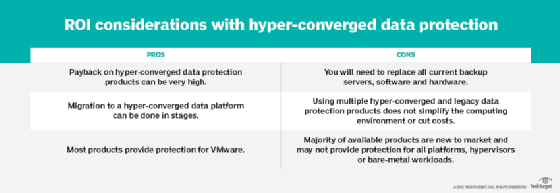ROI considerations with a hyper-converged data protection platform
Do the benefits of a single operating environment and improved cloud support outweigh the costs associated with switching to hyper-converged data protection?
A hyper-converged data protection platform promises to simplify the data protection process and reduce costs by converging the backup server, backup storage and backup software into a single operating environment.
These hyper-converged platforms are primarily software, but typically pre-package scale-out hardware to simplify implementation and upgrades, and to improve technical support. Products in this space also tend to provide more advanced support of public cloud storage, including using the public cloud to archive old backups, acting as a disaster recovery site and even providing backup of native cloud applications.
Challenges with hyper-converged data protection ROI
While hyper-converged data protection vendors vow to simplify the backup process and reduce cost, IT planners need to consider some of the potential downsides carefully. First, almost every organization has a backup platform in place. The chances are high that the organization has been using the incumbent backup for years. It is also likely ingrained in most of the processes within the organization. Along with that backup solution is the necessary hardware investment in backup servers and backup storage.
The move to a hyper-converged data protection platform is more of a commitment than simply switching backup software. It has to replace the organization's backup software, backup servers and backup storage hardware for a full return on the investment. The timing of when to make the switch is critical, and the organization needs to be willing to overlook past investments that create a negative start to ROI. The good news is that the payback on hyper-converged data protection products can be high enough that they easily overcome starting with a negative ROI.

The customer may also choose a gradual migration to the hyper-converged data protection platform by having it protect one problem area, like virtualized infrastructure, while continuing to enjoy the benefits from the legacy backup. While using both approaches minimizes the negative impact of shelving an existing investment, it does slow down the rate of ROI. It also doesn't simplify the environment, since the organization now has to run multiple data protection products.
The second challenge is that most hyper-converged data protection products are relatively new to the market and may not have complete protection for every platform yet. Most provide VMware protection, but only a few protect other hypervisors like Microsoft Hyper-V, Nutanix AHV or Red Hat Virtualization. Also, many do not provide support of bare-metal workloads like Oracle and Microsoft SQL Server. The organization needs to either accelerate its plans to virtualize these environments or it needs to continue to run both data protection products.
Determining hyper-converged platform value
The first consideration when determining the value of a hyper-converged data protection platform is the quality of the current data protection application. If that application is protecting the environment well and is operationally understood, then it minimizes the value of moving to a converged platform. If the organization's motivation is the scale-out hardware aspect of hyper-converged data protection, then there are several vendors with scale-out storage hardware that can work with a variety of backup and archive software.
The second consideration is switching costs and timelines. When a customer starts implementing hyper-converged data protection, there is almost certainly an overlap period where the organization has to run both products simultaneously. The organization also needs to access its backup history, in some cases for years. The extent that the legacy product can downsize is dependent on several things – the variables described above, remaining usable life of current software and hardware, and the level at which the new product can protect the existing environment.
The hyper-converged product should reduce implementation, operational and upgrade expenses. IT planners need to determine how long implementation and upgrades typically take as compared to the current product. Operational justification requires measuring the time it takes to do everyday tasks versus the legacy offering. Part of the operational justification is calculating recovery time differences because most hyper-converged data protection products can provide a "boot from backup" type of capability that can dramatically reduce recovery time objectives.
The cloud factor
Most legacy products, if they support the cloud at all, typically can only use public cloud storage to store a mirror image of backed up data. Many hyper-converged data protection products use the cloud to limit the growth of on-premises backup storage, by archiving it to the cloud. Using the cloud as a backup archive reduces the upfront cost of storing years' worth of backup and it eliminates the data center floor space that backup storage systems consume. There is a downside in that the archive data stored in the cloud is paid for in perpetuity, so IT planners need to factor in ongoing cloud storage costs for the required data retention periods.
Hyper-converged data protection products can use cloud computing for test/dev and disaster recovery, saving the organization the cost of equipping and managing a DR site. That feature makes for a much quicker ROI.
The biggest challenge for data protection architectures is keeping up with the growth in production storage. Constant problems include the time and cost to upgrade these products as well as making sure all three primary data protection resources (software, server and storage) are keeping pace. A hyper-converged data protection platform simplifies the process of keeping pace and typically provides better support of cloud resources. To achieve a rapid ROI, IT planners need to determine if simplification and better cloud support overcome the cost of switching.







